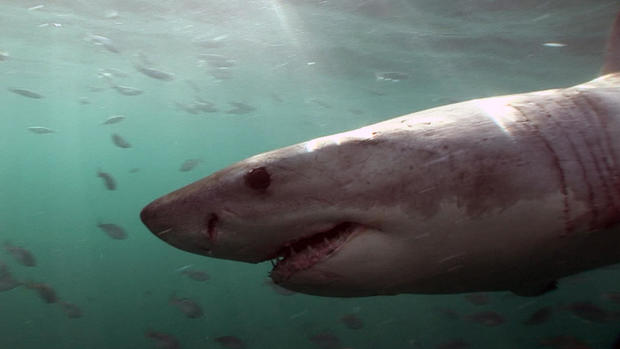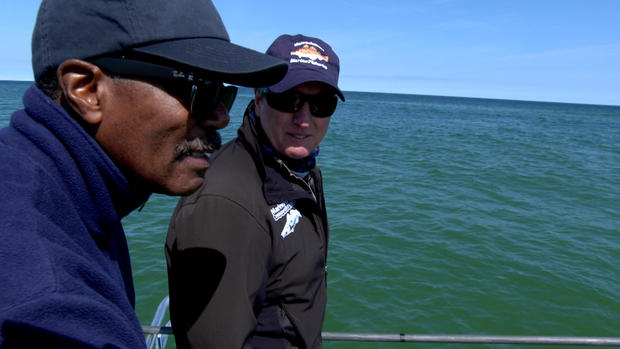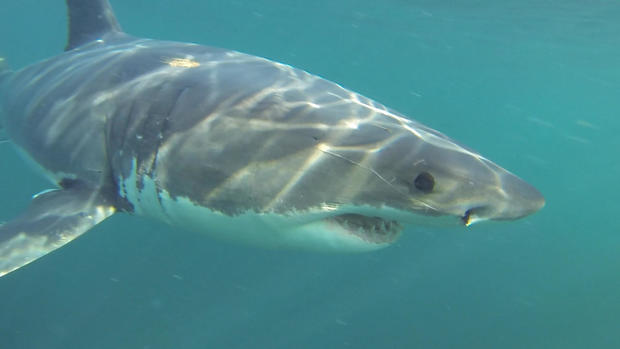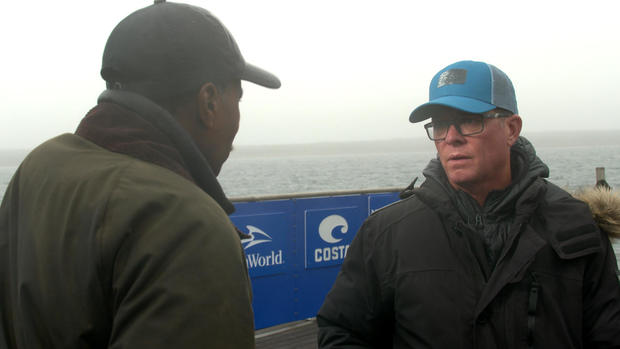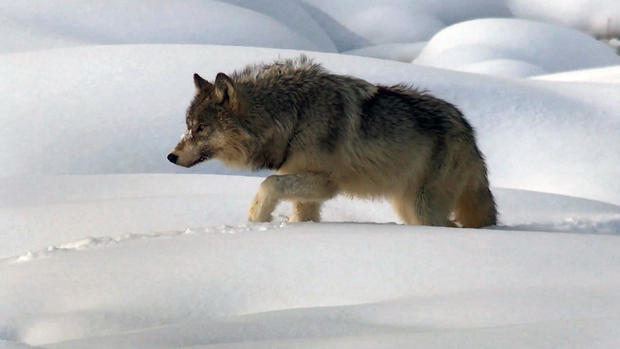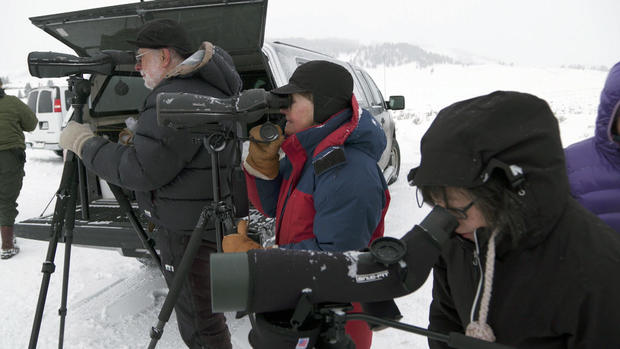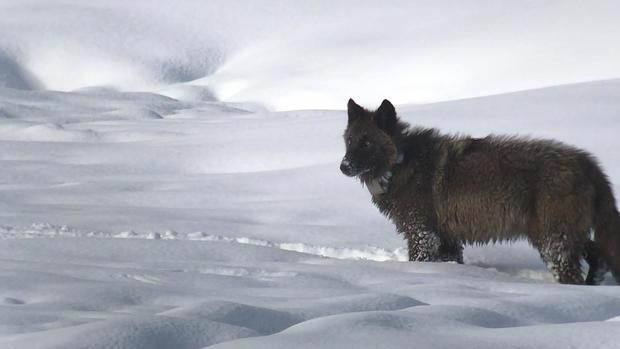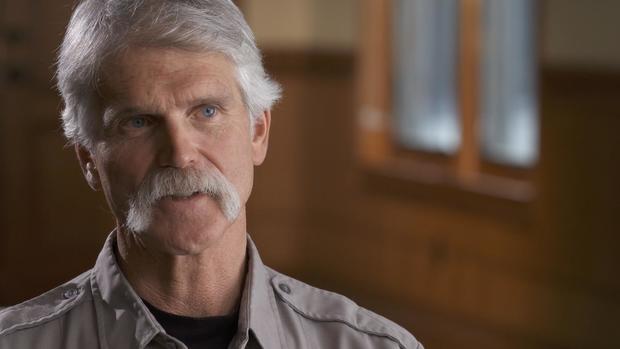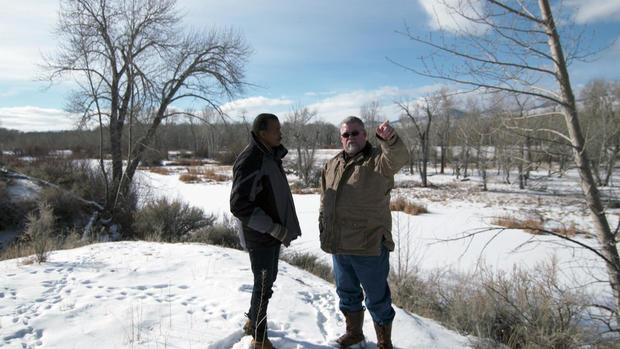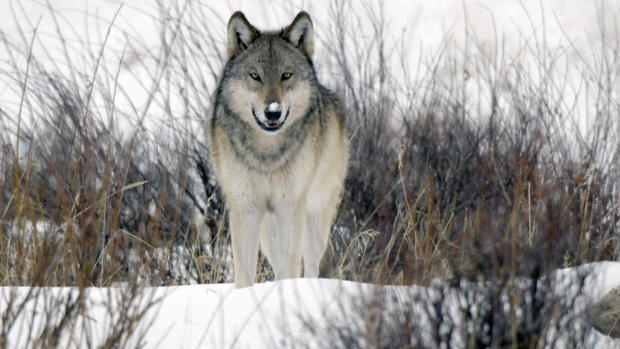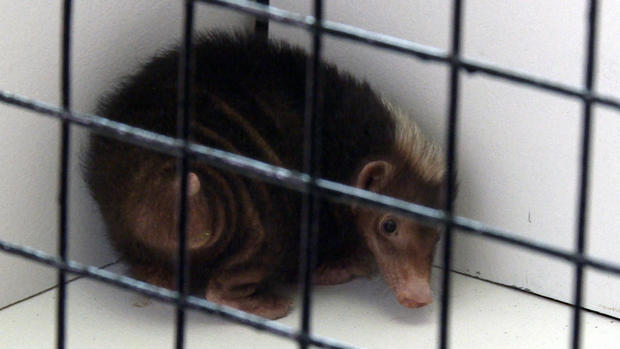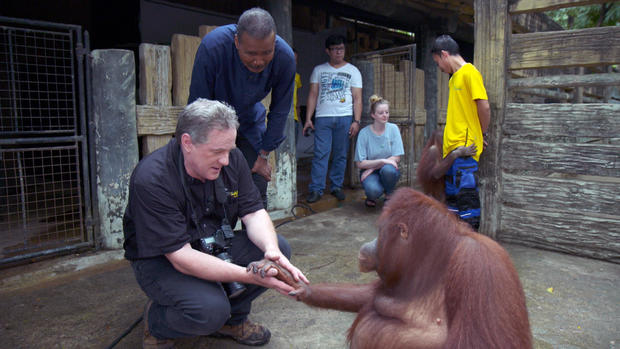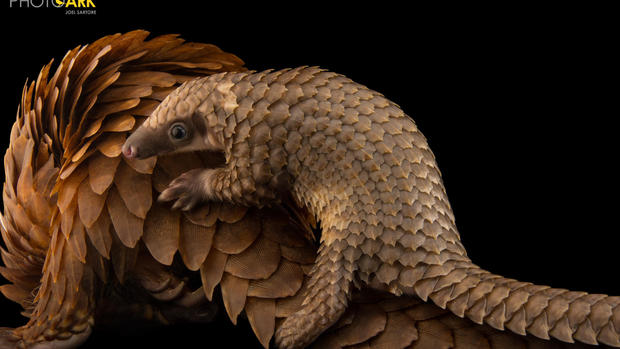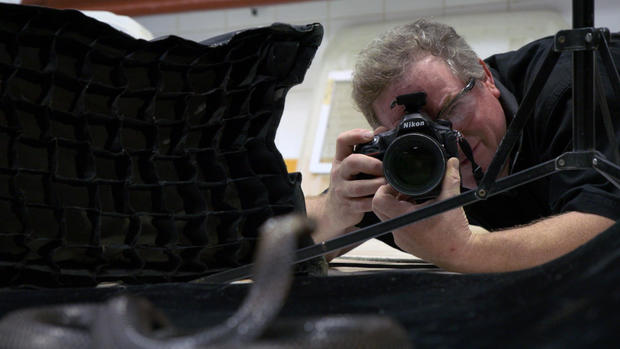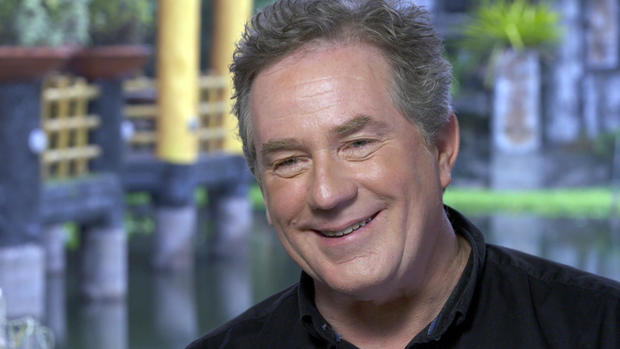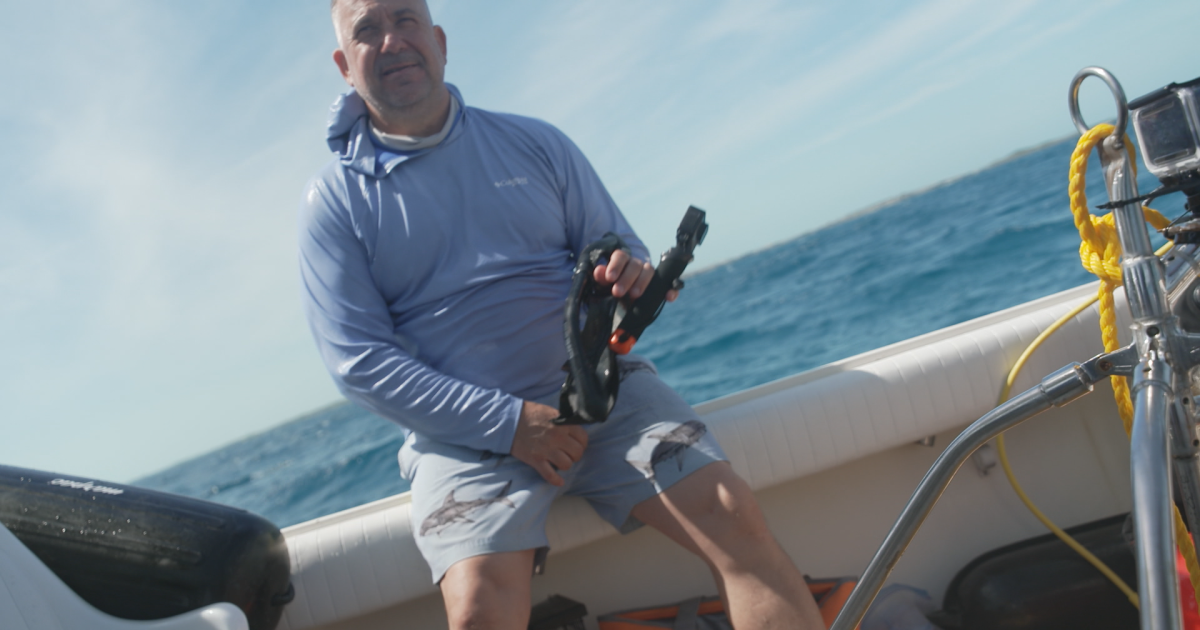60 Minutes Presents: Whitaker's Wildlife Tour
Tonight, we embark on a "wildlife tour." We'll roam with the wolves in the snows of Yellowstone. Marvel at the diversity of the animal world through the lens of a National Geographic photographer. But we begin with a dive into the lives of some of the ocean's most storied and feared predators.
Great White
The book and movie "Jaws" introduced us to the great white shark more than 40 years ago, and scared us out of our wits. Much of the film was shot in the waters off Cape Cod, Massachusetts; the irony is that when it came out in the mid 1970's, there were very few white sharks around Cape Cod.
The species was in the midst of a serious decline, and the movie made it worse. With fishermen hunting the few great whites that there were.
White sharks were granted federal protection in 1997, and in the years since, have made a comeback that has delighted conservationists and frightened swimmers and surfers. On Cape Cod this past summer, shark sightings and beach closings were about as common as lobster rolls. As we first reported last September, the Atlantic great white shark is back.
Greg Skomal: Look at this fish.
Bill Whitaker: Look at this fish.
Greg Skomal: Yeah, look at this fish.
Bill Whitaker: Geez.
On a Tuesday in mid-September, we're with Dr. Greg Skomal, chief shark scientist for the Massachusetts Department of Marine Fisheries, following an 11-foot white shark swimming just feet off the beach near Truro on Cape Cod.
Greg Skomal: And if you're standing there, you don't know that shark's there.
Bill Whitaker: You have no idea!
Greg Skomal: You don't know that shark is there.
Bill Whitaker: No idea. She's like 10 feet off shore!
Greg Skomal: Yeah. Very close now.
White sharks are so close to shore because that's where their favorite food is. Grey seals, thousands of which now call Cape Cod home.
Greg Skomal: This is the restaurant right here. These sharks have found the restaurant, and they're waiting for the doors to open. You know? And when those seals begin to leave the beach… you know?
Bill Whitaker: It's dinnertime.
Greg Skomal: It's dinnertime.
Skomal and his team from the Atlantic White Shark Conservancy are trying to attach electronic tracking tags to as many sharks as they can, nearly 230 so far. The way they do it is fascinating. Pilot Wayne Davis locates sharks from his spotter plane, then guides boat captain John King onto them.
Wayne Davis: Use a little gas, John. He's right on the shoal. It's about as good as it's gonna get.
Standing on a 'pulpit' on the bow of a small boat, Greg Skomal wields a long pole that has a dart and a tag at the end.
Greg Skomal: Right, Right there. Done.
Bill Whitaker: You got him?
Greg Skomal: Tagged.
Bill Whitaker: That was it!
Megan Winton: Beautiful, alright
Captain John King: My God. Beautiful, beautiful placement, Greg.
Greg Skomal: Thank you, John. Nice work.
Bill Whitaker: You can see, you can see where it was?
Greg Skomal: Yeah, you can see it right at the base of the dorsal. See it?
Bill Whitaker: Yeah, yeah, yeah, yeah.
Greg Skomal: Now we're gonna learn about that fish for the next nine, 10 years.
They will track the fish because the tag constantly emits a "ping" that is picked up when the shark swims close to acoustic receivers attached to buoys.
Bill Whitaker: And how many of these do you have up and down the coast?
Greg Skomal: We have over a hundred out all over Massachusetts.
Bill Whitaker: And that's just you. Other people have others.
Greg Skomal: That's just us. Yeah. And so we can actually track the movements of our white sharks when they leave here.
The tags also help Skomal and his research colleague Megan Winton figure out just how many sharks there are, and have established that Cape Cod is now one of the world's white shark "hot spots." They regularly haul buoys out of the water and download data from them to a tablet that displays each time a tagged shark swims by.
Megan Winton: Lots of white shark detections.
This tells them a lot about individuals; they have confirmed that they're loners, and that the same one will often come back to precisely the same hunting ground year after year. A white shark seemed to be hunting Greg Skomal in 2018 when it came up, jaws open, right under the pulpit.
Captain John King: OH! Holy crap!
Greg Skomal: It came right up and opened its mouth right at my feet!
That shook him up for a bit. But he insists it shouldn't shake up the public.
Greg Skomal: All I can tell them is, is that the probability of them being bitten is incredibly low. But there's not much more I can say.
Bill Whitaker: Because that fear is primal.
Greg Skomal: I think that fear is primal. I think it's innate. I think it's in them, it's in us, it's in all of us.
Five days after our day on the water off Cape Cod, we needed a bigger boat, for a very different shark-tagging expedition 600 miles to the northeast, just off hay island in Nova Scotia.
We boarded a 125-foot research ship called Ocearch, which has been tagging Atlantic white sharks from Florida to Canada since 2012. Founder Chris Fischer invited us to join the first day of his 2019 Nova Scotia expedition.
Chris Fischer: And we come up here. We've been here 24 hours. We've seen two or three sharks and no one ever even knew to come look here before.
Ocearch launches a team on a small boat to hook white sharks much as fishermen would, using long lines, bait and floats to keep them near the surface.
Ocearch is a converted Alaskan crab boat equipped with a platform that's lowered into the water off one side. As the small boat tows the shark alongside, Ocearch fishing master Brett McBride leaps onto the submerged platform, into water that's 49 degrees. With the line in his hand, he guides an 1,100-pound male white shark onto the cradle.
Bill Whitaker: Whoa, whoa, look at that.
The platform is raised out of the water, effectively "beaching" the shark. It offers no resistance, worn out after being hooked and "towed" for nearly an hour. McBride gets right in its face to insert a hose between its giant jaws.
Brett McBride: I'm keeping clean seawater flowing over its gills. I'm makin sure it's getting good oxygen.
A team member starts a clock, they don't want to keep the shark out of the water for more than 15 minutes. And Ocearch chief scientist Dr. Robert Heuter gives me an opportunity i'm not quite sure I want.
Dr. Bob Hueter: So Bill, just go ahead, go ahead and take your time, just feel how beautiful that is. (NOISE)
Bill Whitaker: Oh my god.
Dr. Bob Hueter: How smooth. And then go this way. Rub your hand the other way and you feel it's kinda bumpy.
Bill Whitaker: My god.
The Ocearch team swarms the shark, drawing blood and tissue samples, picking off parasites to be analyzed, and measuring its girth and length.
Christian Purcell: 371 total!
That's 371 centimeters, or 12 feet, 2 inches. The biggest Atlantic great white they've caught was a 16-foot female who weighed 3,500 pounds.
As Chris Fischer measures this one, Bob Hueter inserts an acoustic tag like the one Greg Skomal attaches with a dart.
Bill Whitaker: That doesn't harm the shark?
Dr. Bob Hueter: No. It's just, it floats in the body cavity.
Chris Fischer: Let's roll the shark. Everybody step back.
After the shark is rolled onto its belly, Chris Fischer drills through the dorsal fin. He insists it's no more painful than piercing an ear. He's attaching the tag that really sets Ocearch apart in the world of white shark tracking.
Chris Fischer: This spot tag allows us to track this animal in real-time for up to five years.
The spot tag will send a signal to a satellite each time this shark's dorsal fin comes above the surface of the water. Ocearch has put more than 50 of them on Atlantic white sharks, and displays their tracks on its website.
Chris Fischer: And that's how you learn not only where they are, but what they're doing where they are, which is what you need to know to manage. Right? Where's the mating? Where's the birthing? Where's the foraging? Where's the gestating?
While some scientists criticize the Ocearch techniques as too invasive, they are gathering a lot of data; 17 different research projects will get samples and information from a single shark.
Still, there are a lot of unknowns: no white shark has ever been kept in captivity, and no one has ever seen them mate or give birth anywhere. But there are also discoveries: the Ocearch team has confirmed that the waters off Long Island are an important "nursery" for baby whites like these – called "pups."
And back on Cape Cod, acoustic tags are teaching Greg Skomal about just how far adult sharks travel.
Bill Whitaker: What's the most interesting thing you've learned about them?
Greg Skomal: We now know based on the tagging work we've done the last 10 years is that, when they leave Cape Cod, they go down to Florida, and they spend the time in the Gulf of Mexico. And they overwinter in these Southern climates. But since some of these sharks move out into the open Atlantic Ocean, and when they're out in the middle of the Atlantic, they dive down at depths as great as 3,000 feet every day. And there's not a scientist on Earth that can tell you why they do that.
Scientists have learned how long-lived they are.
Greg Skomal: White sharks we now know live over 70 years.
Bill Whitaker: Seventy years?
Greg Skomal: Seventy years.
They don't start hunting seals until their late teens, but when they do, watch out. In this footage Greg Skomal shot, you see a seal leap out of the water with a shark right on its tail.
Here, the shark catches a seal, and the ocean water explodes in blood red in an instant. The shark then swims away with half a seal in its jaws.
Seals have been protected by federal law since 1972, and some 25,000 now live near Cape Cod. More seals means more sharks and that's what worries the swimmers and surfers sharing the water with them.
Great white sharks very rarely attack people. The one that killed a swimmer named Arthur Medici just off this beach last September was the first fatal attack on Cape Cod since 1936. But it triggered a fear of attacks that can hardly be measured.
Scary warning signs on every beach, "stop-bleed kits" at lifeguard stands. A phone app called Sharktivity that reports sightings in real-time, with local news doing much the same, and community meetings packed with frightened citizens.
Bill Whitaker: You're the scientist. But you also live here. And, you know, people are afraid.
Greg Skomal: We can't bury our heads in the sand when it comes to shark attacks. And so that's in my face every day now. And then it always falls back on the-- you know, the question of, "Well, what do you tell your kids to do?" You know?
Bill Whitaker: What do you tell your kids to do?
Greg Skomal: You know, I-- I tell my kids-- don't go out past waist-deep.
That's chilling advice – for swimmers, for surfers, and for the Cape Cod Chamber of Commerce.
Chris Fischer: I mean, we've basically gotta undo everything "Jaws" did. I mean, we've got half the people on the Eastern Seaboard terrified about something that almost never happens.
Bill Whitaker: I saw the teeth on this character here. People who are swimming nearby should not be afraid of that?
Chris Fischer: No. They're clever. Like, even though we dress up like their food and try to fool 'em, they very rarely get fooled.
Bill Whitaker: What do you mean tr-- what do you mean-- dress up like their food?
Chris Fischer: You ever seen what someone in a wetsuit looks like compared to a seal?
He's got a point. When this white shark's 15 minutes on the Ocearch platform ran out, we were ordered off. They gave him a name, Sydney, for the nearest Nova Scotia town, and began lowering him back into the water.
Bill Whitaker: And what you guys have done to him-- this does not harm or hurt the shark at all?
Dr. Bob Hueter: No, because we're-- we're monitoring the stress of the animal throughout.
After a couple of minutes, he perked up, especially when he noticed the Ocearch photographer in the water around the corner.
Finally, with fish-master Brett McBride helping "steer" him by the tail, off went Sydney.
Produced by Rome Hartman. Associate producer, Sara Kuzmarov
The Wolves of Yellowstone
It's safe to say that wolves have an image problem. Since ancient times they've been portrayed in fables and legends and the Bible as fearsome, voracious predators. The story of the big bad wolf may be the most memorable and frightening of all the fairy tales told by the Brothers Grimm.
That "grim" reputation actually produced a very real result in America in the early 20th century. Wolves were wiped off the landscape, trapped, poisoned, and hunted until there was not a single one left in the American West.
The National Park Service brought wolves back to Yellowstone Park almost exactly 25 years ago, following a bitter debate between wildlife groups, who wanted them restored, and ranchers, who most definitely didn't. Even today, the wolves of Yellowstone stir strong emotions, but as we first reported in 2018, they've also had an impact that almost no one saw coming.
In the dead of winter, Yellowstone Park is a beautiful, but forbidding place. Howling wind, sub-zero temperatures, six feet of snow. Just finding enough food to survive is a profound struggle for every animal. Waterfowl, bison, elk, foxes, they all have to work for every morsel.
Yellowstone was the world's first national park, founded in 1872. And it remains one of the most visited; millions of people come here every summer, but they used to pretty much leave it to the wildlife in the winter, until the wolves came back.
Now, reports of a wolf-sighting can produce a traffic jam along the one 50 mile stretch of road the park service keeps open in the winter.
Visitors with spotting scopes gather in absolutely frigid weather for a momentary, long-distance view.
Doug Smith: Bill, these folks came from Germany to see wolves.
Bill Whitaker: How about that.
Doug Smith runs the Yellowstone wolf research program for the park service.
Doug Smith: And no one predicted this would happen. Actually, you know, we--
Bill Whitaker: The appeal of coming in to see the wolves?
Doug Smith: Yes. And it truly has been amazing. And, hundreds of thousands of people a year, we estimate, come here just to see wolves.
"Wolf Tourism" pumps $35 million a year into the local economy, much of it spent in the winter, which is prime wolf-watching time.
Glen Mai: We've seen wolves all three days that we've been out.
Glen Mai is a retired FBI agent from Arlington, Virginia. Kathy Lombard is a retired cop, from New Hampshire. They both paid an outfitter thousands of dollars to take them wolf-watching.
Bill Whitaker: So what is it about wolves that bring you all the way out here from New Hampshire to sit out here and just hope for the chance to see them?
Kathy Lombard: They've been able to bring wolves back into Yellowstone and they've thrived. So that's just an awesome thing to see.
It was January 12, 1995 when the first grey wolves, captured in Canada, were carried into Yellowstone Park. It drew both national attention and fierce opposition, so much that armed guards were posted to protect those wolves.
Bill Whitaker: So, the first wolves released into Yellowstone Park were released right back here in this-- this thicket?
Doug Smith: Yes. So, a total of 41 over three years.
Bill Whitaker: How many are in the park now?
Doug Smith: We've got 96 in ten packs, and it's been roughly 100 wolves the last ten years. Very stable.
Those ten packs of about ten wolves each are without a doubt the most closely observed and studied wolves on earth.
Doug Smith: Our goal is to keep touch with each pack. That's our goal.
They do that by trying to attach radio collars to at least two wolves in each of the park's packs.
Doug Smith: So you fly out in the airplane, find wolves in the open. That airplane radios a waiting helicopter on the ground. That helicopter flies out with a gunner in the backseat.
That gunner is almost always Smith himself.
Doug Smith: And you fly up alongside that wolf. And you shoot a tranquilizing dart into it.
Doug Smith: Five minutes, it goes down. We process the wolves. We take blood. We measure them. We look at their health. And we attach a radio collar. And then we follow them for their life hopefully.
That life, by the way, typically lasts about five years. Yellowstone wolves are fierce and territorial; the leading cause of death is attacks from other wolves.
Doug Smith: And their look is uncontrollable. That look says, "I ain't gonna conform to your rules. And I'll die before I do." And that's powerful.
Data from the radio collars has helped Smith's team to learn volumes about wolf behavior.
It also helps all those wolf watchers find them. Park service volunteer Rick McIntyre is out every day listening for signals and then spreading the word.
Rick McIntyre: Would you like to see a gray wolf?
Bill Whitaker: I would love to.
Rick McIntyre: Okay, here you go. So it's a little bit right of center.
Bill Whitaker: Oh, yeah. Oh, look, here comes a whole pack. Wow.
Rick McIntyre: So see if you count them all. There would be two grays--
Bill Whitaker: One, two--
Rick McIntyre: --and six blacks--
Bill Whitaker: Three, four, five, six black ones, and the white one that went by.
Rick McIntyre: And there should be a second gray.
Bill Whitaker: How about that.
We had spotted the Junction Butte pack along a ridgeline about two miles away. Like most packs, it's led by an alpha male and an alpha female, the only two wolves in a pack who mate with each other.
Rick McIntyre: The gray alpha female is still leading to the right.
Bill Whitaker: Oh, yeah.
Rick McIntyre: And you see how the ones behind her are playing. She's determined to lead them to the west. They're running along the top,
BILL: Right along the ridge, yeah. That's magnificent.
Doug Smith: We can see these wolves from the ground. And it's been a sensation. So we've learned a lot about pack dynamics, and personalities, and-- and how social they are.
Bill Whitaker: What do you mean? Describe that for me.
Doug Smith: They wanna be together. They're a pack animal. So the power of the wolf is the pack.
Nowhere is that power more evident than when a wolf pack is on the hunt for elk, its favorite prey. They work together, because they have to.
Doug Smith: Your average wolf weighs 100 pounds or so. But your average prey animal is much bigger. A bull elk's 750 pounds. A cow elk's 500. So how is a roughly 100 to 120 pound animal gonna take that down?
They do it, Doug Smith says, both by coordinating their attack and by zeroing in on vulnerable prey.
Doug Smith: They're gonna take the weak. So they're making their living off of calf elk, old elk, injured elk.
Without wolves, there was an overpopulation of elk in Yellowstone. As wolves have cut the size of those herds, there's been an unexpected side-effect: plants that elk feed on have made a comeback, which has in turn produced benefits for other species.
Doug Smith: All the little trees have come back since wolf recovery. This gully filled with shrubs has all come back since wolf recovery.
Bill Whitaker: And the wolves are a factor in all of that?
Doug Smith: Very simply put: wolves eat elk; elk eat this. When the elk get reduced, they eat less, so beavers and song birds can respond to the growth and that vegetation.
Doug Smith is quick to say that it's not as simple as he just made it sound, but that hasn't stopped some environmentalists from declaring wolves the "saviors" of Yellowstone's ecology.
Randy Newberg: There's some people who will try to convince you that wolves could probably solve Mideast peace and world hunger.
Randy Newberg is a Montana hunter who hosts a TV show and podcast for hunters. He remembers how emotional the debate over reintroduction was between wolf-haters and wolf lovers.
Randy Newberg: Wolves are wolves. They aren't the big bad wolf and they don't have a rainbow shooting out their ass like everyone would think they do.
Erik Kalsta: There's something romantic about a wolf, right? Unless you've seen it chewing on a live cow.
Erik Kalsta's family has been raising cattle and sheep on this Montana ranch for 100 years. He says he was worried from the moment the first wolves were brought back to Yellowstone, which is about 100 miles to the south.
Erik Kalsta: You know, they weren't gonna stay in the park. They're a wild animal. They'll go where they wanna go.
Bill Whitaker: I'm sure you knew it was only a matter of time before they were gonna get here.
Erik Kalsta: Oh yes. There was no doubt
Erik Kalsta: And there was a set of tracks
Erik Kalsta knew that wolves would follow migrating elk out of Yellowstone and onto his ranch, and that they'd attack his livestock if given the chance. He started hiring range riders to watch over his cattle, and he bought guard dogs to help keep wolves away from his sheep.
Erik Kalsta: Live sheep pay for things, live cattle pay for things. Dead ones don't.
His defensive measures have kept wolves away from his livestock, but neighboring ranchers have lost both cattle and sheep to wolves.
Doug Smith: The thing that's never monitored, when I talk to these people, is the lost nights of sleep, the nervousness; "I saw a wolf track at my place today," or, "I actually saw a wolf. Wolves are around." You can't measure or compensate for that.
Bill Whitaker: Are wolf attacks on livestock-- a serious problem?
Doug Smith: No, it's rare that it happens. But if it's happening to you it's a serious problem.
It was that fear of wolf attacks that drove ranchers and settlers to eradicate them in the early 20th century. After the endangered species act was passed in 1973, wolves were among the first to be listed, and a campaign began to restore them to Yellowstone Park.
After that happened in the 90s, wolves quickly spread out of Yellowstone and into neighboring states, so many that there are now nearly 2,000 in Montana, Wyoming and Idaho. After a long and bitter legal battle, those states finally won the authority to manage, and sometimes kill, wolves outside the national park.
Bill Whitaker: Has this management of the wolves helped to lessen some of those passions, to-- to calm some of those emotions?
Doug Smith: I think so.
Bill Whitaker: So to have wolves you have to kill the wolves?
Doug Smith: In some situations, yes.
The first situation is cut-and-dried: any wolves that attack livestock are immediately killed themselves.
Erik Kalsta: I think that's helped a lot, at least with the ranching community. People feel better if they're not powerless to deal with something.
Doug Smith: And then wolves are hunted. There's a hunting season on wolves. All three states have them. So having wolves be hunted has probably increased people's willingness to share the landscape with them.
Randy Newberg: It looks like there's at least two of them.
Randy Newberg is living proof of that. He filmed a wolf hunt a few years ago for his TV show. It took him 11 days, and a hundred miles of trudging and tracking through the snow.
Bill Whitaker: You went out looking for a wolf and saw how smart they are, how cunning they are, how athletic they are?
Randy Newberg: Yeah. If you want to increase your respect for wolves, go and chase them out on their landscape.
Hunters and ranchers and avid wolf-watchers rarely see eye-to-eye. But they now agree on at least one thing: wolves are back in Yellowstone, for good.
Doug Smith: People love this. You know, we live in an artificial world. It's stores, and cars, and roads, and buildings. Wolves are real. And people crave it. They love it. We almost have this thirst for something real now.
Produced by Rome Hartman and Sara Kuzmarov. Associate producer, LaCrai Mitchell.
The Photo Ark
Joel Sartore, an acclaimed National Geographic photographer, is a man on a mission. He's trying to photograph every species, every animal, bird, fish, reptile and insect, in captivity. As we first reported back in 2018, Joel Sartore sides with scientists who estimate that half the species alive today could be extinct by the end of this century. So he travels to zoos all around the world to take pictures of what we're losing and to ignite conservation efforts to prevent extinctions. He calls his project: The Photo Ark.
On this ark, the animals go in one by one
To catch Joel Sartore in action, we flew halfway around the world to the Philippines, home to hundreds of unique species.
Bill Whitaker: Flew 20 hours to get here. And you came all this way to take a picture of a Palawan Stink Badger?
Joel Sartore: Absolutely. Absolutely. He's smaller than a skunk but smells worse.
He's part-badger, part-skunk and he fired a reeking rocket after he entered the photo cage.
It smelled so terrible that the next animal to leave the red carpet and head into the photo cage, a rare Palawan Binturong, took one whiff, smelled stink badger stink and backed out.
Sartore said he should have photographed the stink badger last, but the little stinker is a pungent prize.
Joel Sartore: There's nobody else coming along to photograph a stink badger. I'm the only one. And that's the case for 90 percent of the species I photograph, maybe 95 percent. These are things that nobody will ever know existed if it weren't for the Photo Ark. If they could see how beautiful this thing is they would care.
"Emotion. That's what you look for in any in any great photograph."
Joel cares so much he spends half the year traveling the world. We saw him work 12-hour days in stifling, humid, hundred degree heat.
It was tough for us just watching him build pop-up studios, switching between backdrops of black and white.
Bill Whitaker: Why did you decide to use either black or white backgrounds?
Joel Sartore: There are no distractions in these pictures. It's just the animal and you. And that animal's often looking you in the eye.
That's when it all works. Here's what happened years ago when Joel tried to photograph a chimp. He spent more than an hour taping up the white background.
More than an hour, for this.
Animals can be frustrating and dangerous, like this fierce Luzon Warty Pig, found only on a few Philippine islands. Handlers had herded him into a makeshift photo pen. Joel got as close as he dared, lying in a trough usually used for pig waste.
Bill Whitaker: The tusks are sharp. The hooves are sharp--
Joel Sartore: Yeah. I, I you know what? I'm concentrating. I got a lot to do.
Beyond the tusks and hooves, this pig packs a mean temper. You've heard the expression: when pigs fly? Watch...
Joel Sartore: Like a cow jumping over the moon, except it was a pig. I've never had that happen, ever. We got our picture. We don't ever need to photograph this species again.
But then, there was Trixie, perhaps the world's sweetest orangutan. We met her not far from the mean-spirited pig at the Avilon Zoo outside Manila.
The key question: would Trixie move in front of the white background?
Joel Sartore: Do You think she would want to stand over there? And get her picture.
Bill Whitaker: She's amazing.
Joel Sartore: Awesome, look at that.
Ellen Sartore: Aw sweet girl.
Bill Whitaker: Covergirl.
Joel Sartore: If she lays down to look at you, you get down with her. You just lay down on the ground and eye level. She was completely calm.
Later, Sartore showed us his favorites Trixie shots, at National Geographic headquarters in Washington.
Bill Whitaker: So what do you think she's thinking?
Joel Sartore: I think she was just thinking, you know, "Is there a banana in this somewhere for me? (laugh) A mango?"
Joel Sartore: I like the white one better I think. It's more direct. It's more like she's involved. She's a partner in the process.
Bill Whitaker: I put my hand out. I wasn't quite sure she was going to take it. But she did.
Joel Sartore: Yeah, it's soft.
Bill Whitaker: And it was soft. Yeah, that was an amazing experience.
Bill Whitaker: What makes a great picture?
Joel Sartore: Emotion. That's what you look for in any in any great photograph.
Bill Whitaker: What's emotion in an animal—
Joel Sartore: A moment. We're looking for the eyes. Humans are we're primates, and we're really really responsive to eyes. We're all about eye contact.
Bill Whitaker: But you shoot 'em like they're models.
Joel Sartore: We do. Like they're going in for their high school senior portrait.
Sartore shoots birds in tents so they won't fly away. This White-Crowned Hornbill, posed like a preening pro. Completely different from Joel's first attempt to shoot this species, back in the states.
Joel Sartore: So this lady, her name's Jen. What she didn't tell me is that bird is such a badass he attacks her when he goes in to feed him.
Joel Sartore: So when I said, "Can you put that bird in my tent?" She went, "Sure I can."
That's why he wanted to shoot a calm hornbill in the Philippines.
But here the Red Rat Snake kept attacking.
Fortunately, he's not venomous, since he bit our cameraman Mark LaGanga.
Joel Sartore: I enjoy seeing a 60 Minutes cameraman get bit instead of me.
But the next snake was extremely venomous.
The Palawan Spitting Cobra can blind you if it spits in your eye and it can spit ten feet. That's why Joel wore goggles. But watch how close he gets to this cobra.
Bill Whitaker: I always thought when they had their hood out like that that meant danger.
Joel Sartore: Well he's reacting to us. We're like skyscrapers to this guy. So he's gonna stand up and look as big as he can.
In zoos Sartore can shoot more than 20 species in one day. In the wild it could take several days to get one good shot. Now, with natural habitats vanishing, some species can only be found in zoos.
Joel Sartore: A lot of 'em only exist in zoos. They have these captive breeding programs for some of the rarest animals in the world. So when people say well, they're down on zoos. Well they haven't seen a good zoo and they don't know the conservation effect of good zoos.
Sartore spent his first 16 years at National Geographic taking pictures in the field. He scored numerous magazine covers, and endured various hardships.
Joel Sartore: Yeah. That's me. That's on Alaska's north slope. I wanted to show the insect load up there. And also I hadn't made a good picture in three days. And so the editors here will say, "Joel, we can't publish your excuses."
Bill Whitaker: The mosquitoes though my god. That's incredible.
Joel Sartore: Yeah. My feet itched for a long time.
He came up with the Photo Ark idea after his wife developed breast cancer.
Joel Sartore: That's my son Cole, and my wife Kathy. She went on chemo for nine months. And I was grounded. I was home for a year. And so I was really worried she was not gonna make it. But we all made it through. She's fine today, it's been 13 years, which is great.
Bill Whitaker: Wonderful.
Joel Sartore: It really does make you appreciate how limited our time is.
Bill Whitaker: So the cancer changed all of your lives.
Joel Sartore: Yeah. And started the Photo Ark. It was a desperate, last-ditch effort to use my life for something that's worthwhile, something that could save nature.
Bill Whitaker: In the Bible, the ark saves all the creatures on Earth. Is that your goal?
Joel Sartore: Exactly. Giddy up. You bet.
Bill Whitaker: What makes you think you can save them with a photo?
Joel Sartore: We can reach more people now than ever. Because we can post to National Geographic, Instagram and Facebook and reach over 100 million people, and do it again and again and again.
His latest pictures are published periodically and they've appeared on the Empire State Building, and the Vatican.
Joel Sartore: Yeah, the side of St Peter's Basilica. The Pope was sittin' there watchin' it, which was awesome.
We flew with Joel to the island of Negros. Here, vast forests were cut for timber, robbing wildlife of vital habitat.
Joel Sartore: Now there's hardly any lowland forest left, less than 5 percent here.
Negros has its own type of critically endangered warty pig. This mother was saved from a hunter's snare. In the zoo, she's helping to save her species.
Joel Sartore: She's got her babies. And you see that bridle marking on her snout that's really definitive.
Bill Whitaker: Oh yeah, oh yeah, that's beautiful.
"At least my life'll be spent doing something that's hopefully mattered to the world"
Joel, who spends so much time away from home, brought his daughter Ellen on this trip.
Bill Whitaker: So what do you think of what he's doing?
Ellen Sartore: I think it's extraordinary, what you're doing.
Joel Sartore: Really?
Ellen Sartore: I do.
Joel Sartore: Aww. You're gonna make me cry.
Ellen Sartore: Don't cry. (laugh)
Joel Sartore: I've never heard you say that. You do?
Ellen Sartore: Yeah.
Bill Whitaker: But he is gone all the time?
Ellen Sartore: He hasn't been to the last seven of my birthdays just because my birthday is in migration season. So he's—
Bill Whitaker: Migration season? (laugh)
Joel Sartore: It's true.
Bill Whitaker: So that's a birthday-buster.
Joel Sartore: Yeah.
The next day Sartore showed us a beetle he had spotted. A species he hadn't shot before.
Bill Whitaker: So there's nothing too small for you huh?
Joel Sartore: Nothing to small. If you can see it with your eyes. We'll photograph it.
Bill Whitaker: How big is this guy?
Joel Sartore: Oh, that guy is the size of a grain of rice.
Bill Whitaker: Tiny.
Joel Sartore: Yea tiny.
Bill Whitaker: So every animal fills up your frame?
Joel Sartore: That's right.
Bill Whitaker: Small or large.
Joel Sartore: He's as big as a polar bear.
Bill Whitaker: Why do you do that?
Joel Sartore: Because it gives 'em all equal say, equal voice. The big, charismatic mammals get all the ink. They get all the press, the gorillas and the rhinos and the tigers. Nobody's thinkin' about these little guys. I am.
Sartore shot another little guy, believed to be the very last member of a now extinct species.
Joel Sartore: That's the last Rabbs Fringe Limbed Frog.
Bill Whitaker: What's that like, knowing that this animal will not exist anymore shortly after you take the picture?
Joel Sartore: Well does it make me sad? Sure. But does it inspire me to go out and keep workin' like I do? Absolutely.
Joel Sartore: We put this together in my office. This just shows you what rodents can look like and what parrots look like. Biodiversity in-- in a glance. Just primates.
Bill Whitaker: Wow.
Joel Sartore: And we've done a lot more since then. We can go out farther and farther and farther. Hundreds of species. Thousands of species. Just amphibians. There's so much diversity but you'd never know it. You'd never know it.
Bill Whitaker: So you've been doing this for how long now?
Joel Sartore: 12 years.
Bill Whitaker: How many species have you photographed?
Joel Sartore: 8,255 but who's counting?
Bill Whitaker: You're about halfway through. And you're how old now?
Joel Sartore: 55, almost 56. Tick tick tick tick tick, just as loud as that 60 Minutes stopwatch baby.
Bill Whitaker: Time's running out.
Joel Sartore: It is. But you know, at least my life'll be spent doing something that's hopefully mattered to the world.
Produced by Robert Anderson and Aaron Weisz.
